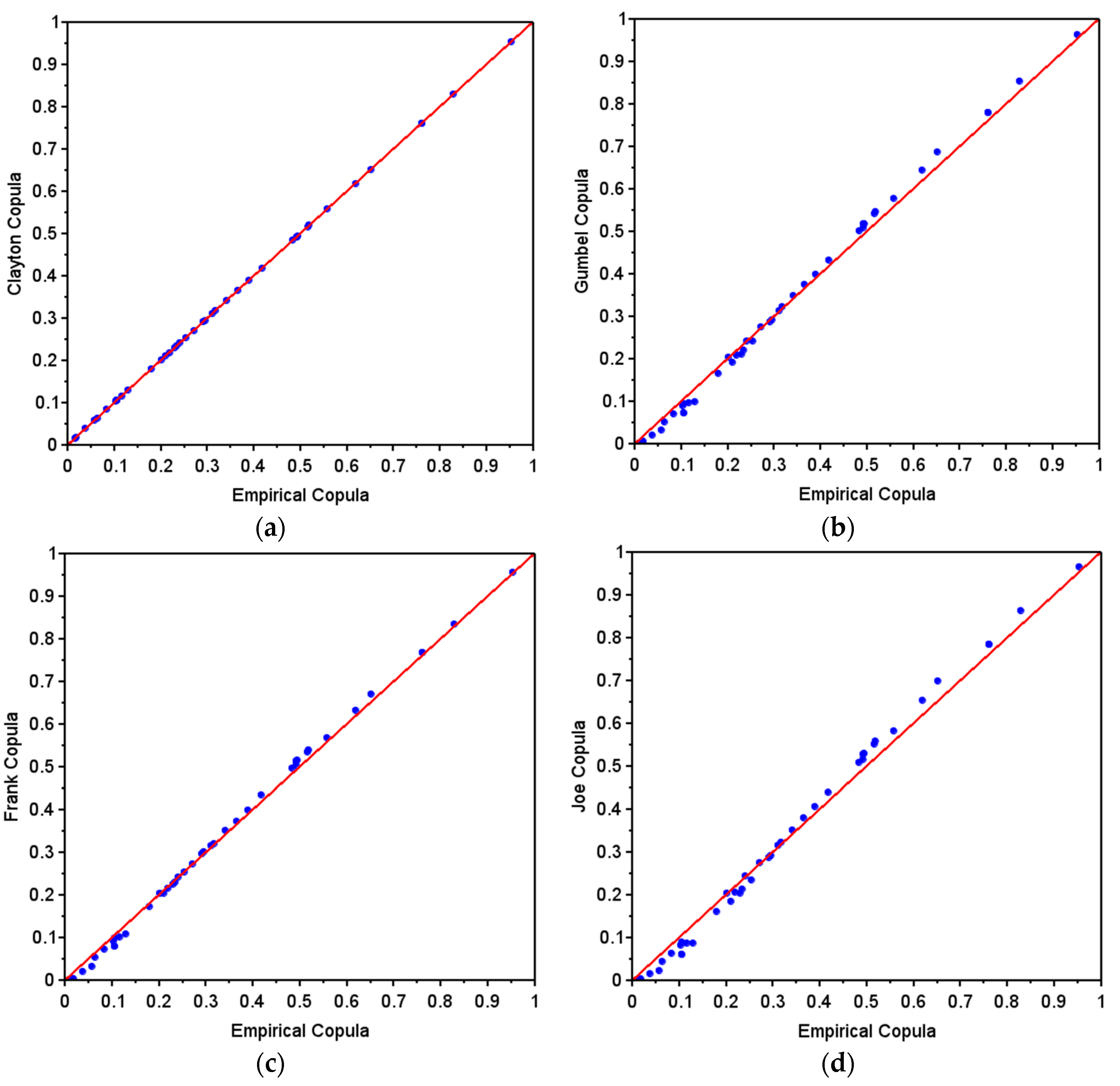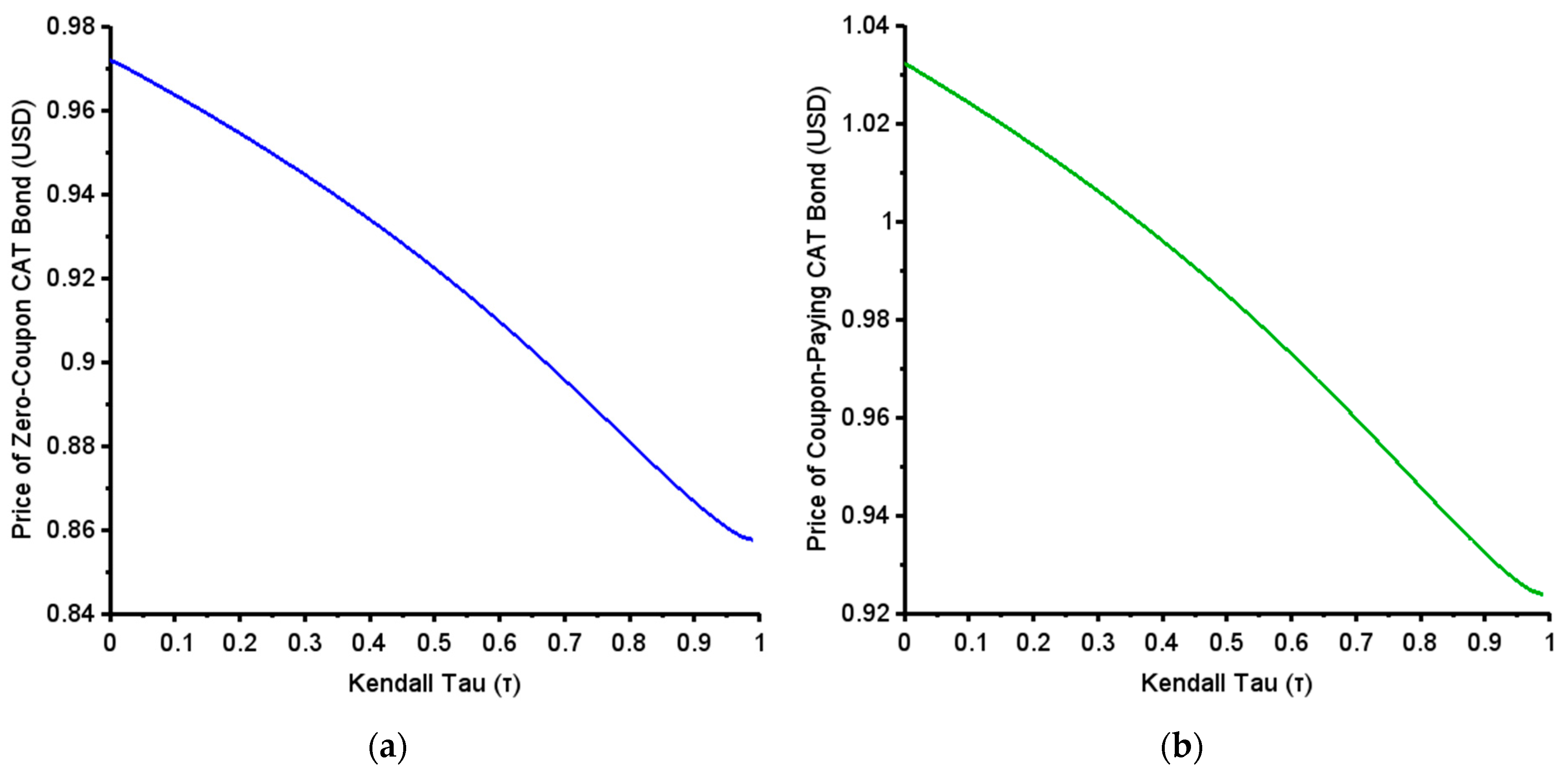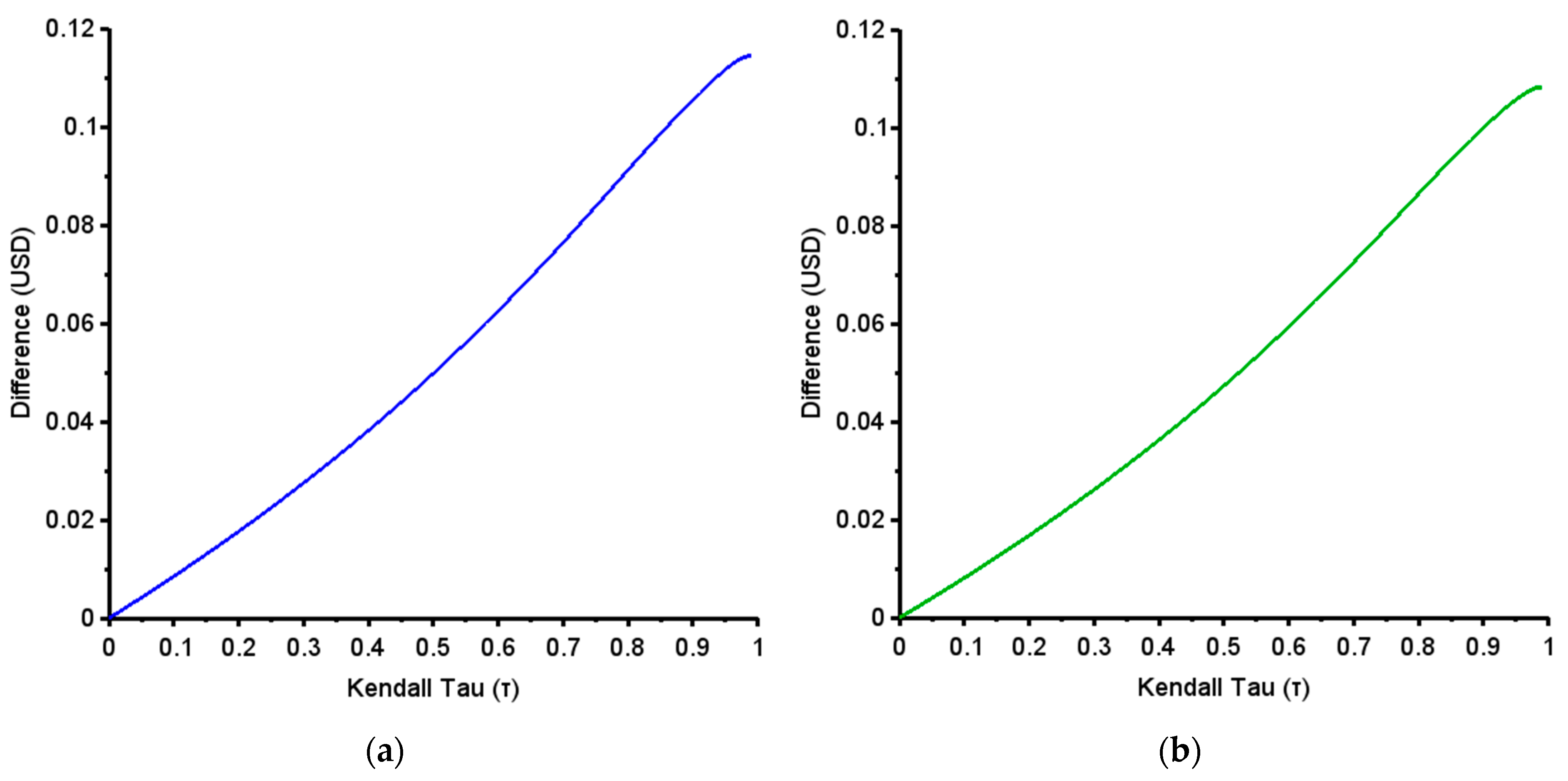Modeling Multiple-Event Catastrophe Bond Prices Involving the Trigger Event Correlation, Interest, and Inflation Rates
Abstract
1. Introduction
2. The Literature Review
3. A Brief MECB Explanation
4. Pricing Framework
4.1. Notations in Modeling
- (a)
- is an integer greater than zero representing the MECB term in years.
- (b)
- represents the principal of the MECB which is paid at maturity.
- (c)
- represents the coupon paid in year .
- (d)
- is the catastrophe frequency that occurs until time in the area stated in the MECB contract.
- (e)
- represents the -th catastrophe loss that occurs in the area stated in the MECB contract.
- (f)
- represents the number of fatalities of the -th catastrophe that occurs in the area stated in the MECB contract.
- (g)
- represents the catastrophe loss aggregate until time .
- (h)
- represents the catastrophe fatality aggregate until time .
- (i)
- represents the correlation rate of trigger events.
- (j)
- represents the attachment point of the catastrophe loss aggregate.
- (k)
- represents the attachment point of the catastrophe fatality aggregate.
- (l)
- represents the first time the catastrophe loss aggregate exceeds its attachment points.
- (m)
- represents the first time the catastrophe fatality aggregate exceeds its attachment points.
- (n)
- represents the first time one of the catastrophe loss or fatality aggregates exceeds the attachment point.
- (o)
- represents the first time the catastrophe loss and fatality aggregates exceed the attachment point.
- (p)
- represents the annual real interest rate in year .
- (q)
- represents the annual nominal interest rate in year .
- (r)
- represents the annual inflation rate in year .
- (s)
- represents the zero-coupon MECB price with a term of year.
- (t)
- represents the coupon-paying MECB price with a term of year.
4.2. The Compound Poisson Process in Modeling Loss and Fatality Aggregates
4.3. Trigger Events
4.4. The Copula in Modeling the Joint Distribution of Trigger Events
4.5. The Annual Real Interest Rate Dynamics
4.6. The Formulation of Zero-Coupon MECB Price Model
4.7. The Formulation of Coupon-Paying MECB Price Model
5. Simulation
5.1. Overview of Data
- (a)
- Data on adjusted nonzero single storm catastrophe losses in the United States from 2012 to 2021.
- (b)
- Data on the number of nonzero single storm catastrophe fatalities in the United States from 2012 to 2021.
- (c)
- Data on storm catastrophe frequency in the United States from 1980 to 2021.
- (d)
- Data on adjusted annual losses and fatalities from storm catastrophes in the United States from 1980 to 2021.
- (e)
- Data on the annual federal reserve and inflation rates in the United States from 1979 to 2021.
- (a)
- The random variable , which is the -th catastrophe loss, follows the Weibull distribution with shape parameter and scale parameter .
- (b)
- The random variable , which is the number of fatalities of the -th catastrophe, follows the Geometric distribution with parameter .
- (c)
- The Skewness of is 3.2973.
5.2. Modeling the Copula of the Trigger Events
5.3. Modeling Real Interest Rate with Integrated Autoregressive Vector Model
5.4. Numerical Methods for Simulation
- (a)
- Initialize that , , , and .
- (b)
- Loop for as follows: Compute . Then, determine the value of . If , then and . However, if , then and .
- (c)
- Compute as follows: .
5.5. MECB Price Estimation
- (a)
- The MECB term is years.
- (b)
- The MECB principal is USD.
- (c)
- The MECB coupon is USD.
- (d)
- The attachment points of loss and fatality aggregates are billion USD and people, respectively. These values are three times the average annual loss and fatality aggregates.
- (e)
- The principal payment proportion when both attachment points are exceeded for the first time is .
- (f)
- The Kendall tau correlation rate of events is .
- (g)
- The interest rate used is presented in Table 4.
- (h)
- The inflation rate used is presented in Table 4.
- (i)
- The annual storm catastrophe intensity is catastrophes per year.
6. Discussion
6.1. The Effect of the Correlation Rate of Events on MECB Prices
6.2. The Effect of the Stochasticity of Inflation and Interest Rates on MECB Prices
7. Conclusions
Author Contributions
Funding
Institutional Review Board Statement
Informed Consent Statement
Data Availability Statement
Acknowledgments
Conflicts of Interest
Appendix A
Appendix B
References
- Coval, J.D.; Jurek, J.W.; Stafford, E. Economic catastrophe bonds. Am. Econ. Rev. 2009, 99, 628–666. Available online: http://www.jstor.org/stable/25592477 (accessed on 13 July 2022). [CrossRef]
- Jaimungal, S.; Chong, Y. Valuing clustering in catastrophe derivatives. Quant. Financ. 2013, 14, 259–270. [Google Scholar] [CrossRef]
- D’Arcy, S.P.; France, V.G. Catastrophe futures: A better hedge for insurers. J. Risk Insur. 1992, 59, 575–600. [Google Scholar] [CrossRef]
- Johnson, L. Catastrophe bonds and financial risk: Securing capital and rule through contingency. Geoforum 2013, 45, 30–40. [Google Scholar] [CrossRef]
- Cummins, J.D. CAT bonds and other risk-linked securities: State of the market and recent developments. Risk Manag. Insur. Rev. 2008, 11, 23–47. [Google Scholar] [CrossRef]
- Zeller, W. Securitization and Insurance: Characteristics of Hannover Re’s Approach. Geneva Pap. 2008, 33, 7–11. Available online: http://www.jstor.org/stable/41952967 (accessed on 15 July 2022). [CrossRef]
- Beer, S.; Braun, A.; Marugg, A. Pricing industry loss warranties in a Lévy–Frailty framework. Insur. Math. Econ. 2019, 89, 171–181. [Google Scholar] [CrossRef]
- Laster, D.; Raturi, M. What drives financial innovation in the insurance industry? J. Risk Financ. 2002, 3, 36–47. [Google Scholar] [CrossRef]
- Härdle, W.K.; Cabrera, B.L. Calibrating CAT bonds for Mexican earthquakes. J. Risk Insur. 2010, 77, 625–650. [Google Scholar] [CrossRef]
- Anggraeni, W.; Supian, S.; Sukono; Halim, N.B.A. Earthquake catastrophe bond pricing using extreme value theory: A mini-review approach. Mathematics 2022, 10, 4196. [Google Scholar] [CrossRef]
- Deng, G.; Liu, S.; Li, L.; Deng, C. Research on the pricing of global drought catastrophe bonds. Math. Probl. Eng. 2020, 2020, 3898191. [Google Scholar] [CrossRef]
- Sukono; Juahir, H.; Ibrahim, R.A.; Saputra, M.P.A.; Hidayat, Y.; Prihanto, I.G. Application of compound Poisson process in pricing catastrophe bonds: A systematic literature review. Mathematics 2022, 10, 2668. [Google Scholar] [CrossRef]
- Woo, G. Territorial diversification of catastrophe bonds. J. Risk Financ. 2001, 2, 39–45. [Google Scholar] [CrossRef]
- Organization for Economic Cooperation and Development (OECD). Terrorism Risk Insurance in OECD Countries; Policy Issues in Insurance; OECD Publishing: Paris, France, 2005. [Google Scholar] [CrossRef]
- Woo, G. A catastrophe bond niche: Multiple event risk. In Proceedings of the NBER Insurance Workshop, Cambridge, UK, 6–7 February 2004. [Google Scholar]
- Reshetar, G. Pricing of Multiple-Event Coupon Paying CAT Bond; Working Paper; Swiss Banking Institute: Zürich, Switzerland, 2008. [Google Scholar]
- Ling, T.; Tianyuan, L.; Fei, Z. The pricing of catastrophe bond by Monte Carlo simulation. In Proceedings of the International Conference on Risk Management and Engineering Management, Beijing, China, 4–6 November 2008. [Google Scholar]
- Sun, L.; Turvey, C.G.; Jarrow, R.A. Designing catastrophic bonds for catastrophic risks in agriculture: Macro hedging long and short rains in Kenya. Agric. Financ. Rev. 2015, 75, 47–62. [Google Scholar] [CrossRef]
- Chao, W.; Zou, H. Multiple-event catastrophe bond pricing based on CIR-Copula-POT model. Discret. Dyn. Nat. Soc. 2018, 2018, 5068480. [Google Scholar] [CrossRef]
- Ibrahim, R.A.; Sukono; Napitupulu, H.N. Multiple-trigger catastrophe bond pricing model and its simulation using numerical methods. Mathematics 2022, 10, 1363. [Google Scholar] [CrossRef]
- Wei, L.; Liu, L.; Hou, J. Pricing hybrid-triggered catastrophe bonds based on copula-EVT model. Quant. Financ. Econ. 2022, 6, 223–243. [Google Scholar] [CrossRef]
- Jarrow, R.A. A simple robust model for CAT bond valuation. Financ. Res. Lett. 2010, 7, 72–79. [Google Scholar] [CrossRef]
- Groenewold, N. The adjustment of the real interest rate to inflation. Appl. Econ. 1989, 21, 947–956. [Google Scholar] [CrossRef]
- Carmichael, J.; Stebbing, P.W. Fisher’s paradox and the theory of interest. Am. Econ. Rev. 1983, 73, 619–630. Available online: https://www.jstor.org/stable/1816562 (accessed on 4 September 2022).
- Zimbidis, A.A.; Frangos, N.E.; Pantelous, A.A. Modeling earthquake risk via extreme value theory and pricing the respective catastrophe bonds. ASTIN Bull. 2007, 37, 163–183. [Google Scholar] [CrossRef][Green Version]
- Nowak, P.; Romaniuk, M. Pricing and simulations of catastrophe bonds. Insur. Math. Econ. 2012, 52, 18–28. [Google Scholar] [CrossRef]
- Nowak, P.; Romaniuk, M. Valuing catastrophe bonds involving correlation and CIR interest rate model. Comput. Appl. Math. 2018, 37, 365–394. [Google Scholar] [CrossRef]
- Liu, J.; Xiao, J.; Yan, L.; Wen, F. Valuing catastrophe bond involving credit risks. Math. Probl. Eng. 2014, 2014, 563086. [Google Scholar] [CrossRef]
- Ma, Z.G.; Ma, C.Q. Pricing catastrophe risk bonds: A mixed approximation method. Insur. Math. Econ. 2013, 52, 243–254. [Google Scholar] [CrossRef]
- Chaubey, Y.P.; Garrido, J.; Trudeau, S. On the computation of aggregate claims distributions: Some new approximations. Insur. Math. Econ. 1998, 23, 215–230. [Google Scholar] [CrossRef]
- Tang, Q.; Yuan, Z. CAT bond pricing under a product probability measure with POT risk characterization. ASTIN Bull. 2019, 49, 457–490. [Google Scholar] [CrossRef]
- Ma, Z.; Ma, C.; Xiao, S. Pricing zero-coupon catastrophe bonds using EVT with doubly stochastic Poisson arrivals. Discret. Dyn. Nat. Soc. 2017, 2017, 3279647. [Google Scholar] [CrossRef]
- Burnecki, K.; Kukla, G.; Taylor, D. Pricing catastrophe bonds. In Statistical Tools for Finance and Insurance, 2nd ed.; Cizek, P., Härdle, W., Weron, R., Eds.; Springer: Berlin, Germany, 2005; pp. 97–114. [Google Scholar] [CrossRef]
- Cummins, J.D.; Weiss, M.A. Convergence of insurance and financial markets: Hybrid and securitized risk-transfer solutions. J. Risk Insur. 2009, 76, 493–545. [Google Scholar] [CrossRef]
- Loubergé, H.; Kellezi, E.; Gilli, M. Using catastrophe-linked securities to diversity insurance risk: A financial analysis of CAT bonds. J. Insur. Issues 1999, 22, 125–146. [Google Scholar]
- Dickson, D.C.M. Insurance Risk and Ruin; Cambridge University Press: Cambridge, UK, 2005; pp. 83–89. [Google Scholar]
- Klugman, S.A.; Panjer, H.H.; Willmot, G.E. Loss Models: From Data to Decisions, 4th ed.; John Wiley & Sons: Hoboken, NJ, USA, 2019; pp. 151–157. [Google Scholar]
- Salvadori, G.; Michele, C.D.; Kottegoda, N.T.; Rosso, R. Extremes in Nature: An Approach Using Copulas; Springer: Dordrecht, The Netherlands, 2007; pp. 131–141. [Google Scholar]
- Ross, S.M. Stochastic Processes, 2nd ed.; John Wiley & Sons: Hoboken, NJ, USA, 1996; pp. 98–100. [Google Scholar]
- Li, J.; Balasooriya, U.; Liu, J. Using hierarchical Archimedean copulas for modelling mortality dependence and pricing mortality-linked securities. Ann. Actuar. Sci. 2021, 15, 505–518. [Google Scholar] [CrossRef]
- Hasebe, T. Copula-based maximum-likelihood estimation of sample-selection models. Stata J. 2013, 13, 547–573. [Google Scholar] [CrossRef]
- Dhaene, J. Stochastic interest rates and autoregressive integrated moving average processes. ASTIN Bull. 1989, 19, 43–50. [Google Scholar] [CrossRef][Green Version]
- Kierzkowski, H. A Generalization of the Fisher Equation. Econ. Rec. 1979, 55, 261–266. [Google Scholar] [CrossRef]
- Kyereme, S.S. Exchange rate, price, and output interrelationships in Ghana: Evidence from vector autoregressions. Appl. Econ. 1991, 23, 1801–1810. [Google Scholar] [CrossRef]
- Ruch, F.; Balcilar, M.; Gupta, R.; Modise, M.P. Forecasting core inflation: The case of South Africa. Appl. Econ. 2020, 52, 3004–3022. [Google Scholar] [CrossRef]
- Wei, W.W.S. Time Series Analysis: Univariate and Multivariate Methods, 2nd ed.; Pearson Addison Wesley: White Plains, NY, USA, 2006; pp. 384–386. [Google Scholar]
- Nagler, T.; Schepsmeier, U.; Stoeber, J.; Brechmann, E.C.; Graeler, B.; Erhardt, T.; Almeida, C.; Min, A.; Czado, C.; Hofmann, M.; et al. Package ‘VineCopula’. Available online: https://cran.r-project.org/web/packages/VineCopula/VineCopula.pdf (accessed on 16 June 2022).
- Trapletti, A.; Hornik, K.; LeBaron, B. Package ‘Tseries’. Available online: https://cran.r-project.org/web/packages/tseries/tseries.pdf (accessed on 16 June 2022).
- Tsay, R.S. Package ‘MTS’. Available online: https://cran.r-project.org/web/packages/MTS/MTS.pdf (accessed on 16 June 2022).
- Tsay, R.S. Multivariate Time Series Analysis with R and Financial Application; John Wiley & Sons: Hoboken, NJ, USA, 2014; pp. 63–64. [Google Scholar]
- Kocherlakota, N.R. Stabilization with fiscal policy. J. Monet. Econ. 2022, 131, 1–14. [Google Scholar] [CrossRef]
- Nuel, G. Cumulative distribution function of a geometric Poisson distribution. J. Stat. Comput. Simul. 2008, 78, 385–394. [Google Scholar] [CrossRef]






| Author(s) | The Trigger Event Indices | The Main Methods | Factor Involvement | ||
|---|---|---|---|---|---|
| Trigger Event Correlation Rate | Stochastic Interest Rate | Stochastic Inflation Rate | |||
| Reshetar [16] | Loss and fatality | Copula, representative agent pricing model, geometric Brownian motion, and Monte Carlo method | Yes | Yes | No |
| Sun et al. [18] | Long-term and short-term rainfall | Jarrow’s model [22] and Monte Carlo method | Yes | Yes | No |
| Chao and Zou [19] | Loss and fatality | Copula, homogeneous compound Poisson process, Cox–Ingersoll–Ross model, and Monte Carlo method | Yes | Yes | No |
| Ibrahim et al. [20] | Loss and fatality | Nonhomogeneous compound Poisson process, ARIMA model, continuous distribution approximation method, and Nuel recursive method | No | Yes | No |
| Wei et al. [21] | Magnitude and loss of earthquakes | Copula, extreme-value approach, homogeneous compound Poisson process, and Cox–Ingersoll–Ross model | Yes | Yes | No |
| Copula | Parameter Estimator | KS Statistical Test Value |
|---|---|---|
| Clayton | 0.9749 | 0.1002 |
| Gumbel | 1.4875 | 0.1463 |
| Frank | 3.2404 | 0.1334 |
| Joe | 1.8818 | 0.1839 |
| Order | 1 | 2 | 3 | 4 | 5 | 6 | 7 | 8 | 9 | 10 |
|---|---|---|---|---|---|---|---|---|---|---|
| AIC Value | −4.3011 | −4.5918 | −4.5053 | −4.4036 | −4.3437 | −4.3413 | −4.3253 | −4.2952 | −4.4076 | −4.3345 |
| BIC Value | −4.1684 | −4.3264 | −4.1072 | −3.8728 | −3.6802 | −3.5450 | −3.3964 | −3.2336 | −3.2132 | −3.4040 |
| HQIC Value | −4.2487 | −4.4870 | −4.3480 | −4.1938 | −4.0815 | −4.0266 | −3.9583 | −3.8757 | −3.9357 | −4.0245 |
| Year | 1 | 2 | 3 |
|---|---|---|---|
| 0.2985 | 0.6008 | 0.6111 | |
| 1.6427 | 1.7441 | 1.7674 |
| Zero-Coupon MECB Price (USD) | Coupon-Paying MECB Price (USD) | |
|---|---|---|
| Constant inflation and interest rates | 0.9563 | 1.0152 |
| Stochastic inflation and interest rates | 0.9417 | 1.0034 |
| Difference (USD) | 0.0146 | 0.0118 |
Publisher’s Note: MDPI stays neutral with regard to jurisdictional claims in published maps and institutional affiliations. |
© 2022 by the authors. Licensee MDPI, Basel, Switzerland. This article is an open access article distributed under the terms and conditions of the Creative Commons Attribution (CC BY) license (https://creativecommons.org/licenses/by/4.0/).
Share and Cite
Sukono; Ibrahim, R.A.; Saputra, M.P.A.; Hidayat, Y.; Juahir, H.; Prihanto, I.G.; Halim, N.B.A. Modeling Multiple-Event Catastrophe Bond Prices Involving the Trigger Event Correlation, Interest, and Inflation Rates. Mathematics 2022, 10, 4685. https://doi.org/10.3390/math10244685
Sukono, Ibrahim RA, Saputra MPA, Hidayat Y, Juahir H, Prihanto IG, Halim NBA. Modeling Multiple-Event Catastrophe Bond Prices Involving the Trigger Event Correlation, Interest, and Inflation Rates. Mathematics. 2022; 10(24):4685. https://doi.org/10.3390/math10244685
Chicago/Turabian StyleSukono, Riza Andrian Ibrahim, Moch Panji Agung Saputra, Yuyun Hidayat, Hafizan Juahir, Igif Gimin Prihanto, and Nurfadhlina Binti Abdul Halim. 2022. "Modeling Multiple-Event Catastrophe Bond Prices Involving the Trigger Event Correlation, Interest, and Inflation Rates" Mathematics 10, no. 24: 4685. https://doi.org/10.3390/math10244685
APA StyleSukono, Ibrahim, R. A., Saputra, M. P. A., Hidayat, Y., Juahir, H., Prihanto, I. G., & Halim, N. B. A. (2022). Modeling Multiple-Event Catastrophe Bond Prices Involving the Trigger Event Correlation, Interest, and Inflation Rates. Mathematics, 10(24), 4685. https://doi.org/10.3390/math10244685








